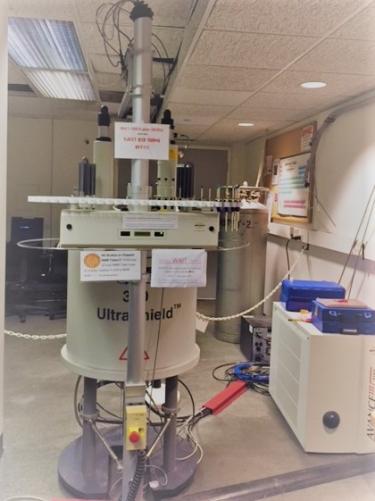High-Resolution solution phase NMR with full Automation
Have your data emailed to you when the acquisition is completed!
Use this instrument for 1H, 19F, 19F{1H}, 13C, 11B, 31P, 29Si, 195Pt, or practically any "X" nucleus with automatic probe-tuning.
This new, truly state-of-the-art NMR spectrometer, operating at 300MHz for 1H observation was installed in June/July 2009. This instrument is fully capable of performing any 1D or 2D NMR experiment possible on a 2-channel NMR spectrometer The instrument is equipped with a single 5mm BBFO probe, with Variable Temperature capability. The probe has the latest Auto Tune & Match (ATM) capability, to automatically tune and match the probe for all nuclei. This means that you can setup any sample or samples to acquire multiple broadband nuclei, with no user intervention required (in terms of probe tuning or any changing of cables).
The 300 is normally operated using the ICON-NMR automation interface, and is not reserved in advance ("Bare Bones" guide to using ICON-NMR). Samples can be submitted on a first-come, first-served basis. Longer experiments (> 30-40 minutes) can be submitted to the overnight queue at any time during the day. For example one could submit a sample for 1H, 2D-gCOSY, 13C, 1H-13C-gHSQC, and have the quick 1H & gCOSY acquire immediately, and submit the 13C & gHSQC to the night queue. The sample will remain in the sample-chager, and the instrument will re-insert the sample, tune/match the probe, shim, and acquire the longer experiments automatically.
The key features of the AV-III 300 include:
- BACS-60, sample-changer capable of holding 60 samples at a time in the queue for automated NMR analysis.
- BBFO/ATM probe, optimized for maximum sensitivity for "X"(broadband) nuclei, from 19F to 15N. This is our most sensitive instrument for 19F and 31P.
- Minimal training is required (approx. 10 minutes) for users to learn to perform even sophisticated 2D NMR experiments (such as spectral-width optimized adiabatic gHSQC with sensitivity enhancement).
- Bruker's newest shimming method, "Topshim", provides the benefits of lineshape-optimized gradient shimming that works for all deuterated solvents, even those that are difficult to gradient shim like Pyridine-d5, Methanol-d4, THF-d8, ...etc.
- Since the probe is perfectly tuned & matched on every sample, one need not worry about sensitivy loss when changing from low-dialectric solvents (i.e. CDCl3) to high-dialectric solvents (i.e. DMSO-d6, D2O, or Methanol-d4). (AN example, comparing the new 300 vs. the Inova-400 for 13C sensitivity)
- Users can submit multiple samples and/or experiments in automation, and the instrument will email the data to the user as soon as the acquisition is completed. The user can use offline processing software, such as MestReNova, to analyze the data wherever they are. (Note: we have a campus site-license for MestReNova).
